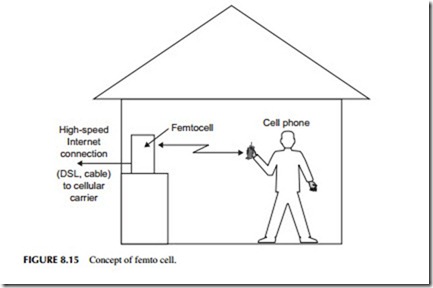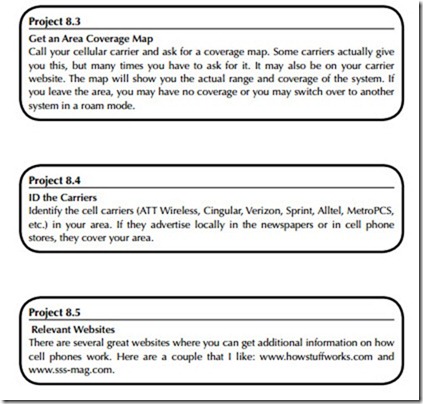THE LATEST CELL PHONE TECHNOLOGY
The cell phone industry is one of the fastest changing in electronics. New products come out almost daily. And new features and capabilities are invented regularly to keep the technology fresh and the sales continuous. Here is a snap- shot in time of the latest cell phone developments.
Smartphones
A smartphone is a basic cell phone but with advanced features that expand its use. The basic cell phone does phone calls or at most handles text messaging as well. But a smartphone has multiple functions. Some examples of smart- phones are the BlackBerry models from Research in Motion (RIM), Apple’s iPhone, some Nokia models, the Palm Pre, and various models from Samsung, LG, and Motorola. They are too numerous to mention and they go out of date monthly or yearly.
High-speed data capability. Most smartphones use 3G technology, so they can deliver almost as fast a data rate as your home Internet connections, usually 1 to 2 Mbps or better.
Internet access. A built-in browser lets you access the Internet just as you would from your home laptop. The main limitation is the small screen size, which prevents you from doing as much as you would like, but you can still do it.
Email. Email is one of the key features of a smartphone. It lets you stay in touch without a PC or laptop.
Messaging. It goes without saying that text messaging is a main data feature.
Digital camera. Most smartphones have an excellent high-resolution cam- era built in. It is not as great as a stand-alone digital camera, but it does have 1 to 3 megapixels of resolution.
Camcorder. Some of the digital cameras have video capability as well. The main limitation is the amount of memory available to store videos. MP3/iPod. A music player is a standard feature of many smart phones. The key here is to have sufficient flash memory to store the songs you want. Wireless local area network (WLAN) access. You will learn more about this in the next chapter, but a smartphone has a built-in separate transceiver to connect to a Wi-Fi hot spot or other access point in airports, hotels, coffee shops, and other locations just like a laptop. You can access the Internet or email as an alternative to doing it through the cellular network.
Bluetooth. Bluetooth is another short-range wireless technology covered in Chapter 9. It is used in smartphones for wireless headsets. A headset contains a headphone and a microphone that fits in the ear. It talks to the cell phone wirelessly via a Bluetooth link.
GPS. The global positioning system is the worldwide satellite navigation system. Many phones have a built-in GPS receiver so that you can find your way. Some even offer full navigation software and display as in those personal navigation devices (PNDs) like those from Garmin and Tom Tom.
Femtocells
One of the most frustrating problems cell phone users have is poor cover- age at home. Many homes are not located near cell sites or have poor indoor performance. This is maddening to many, especially those who want to give up their regular wired home phone and go only wireless. One solution to this problem is the femtocell. This is a small base station designed to be installed at home. The concept is illustrated in Figure 8.15. It can usually accommo- date calls from up to four cell phones. The femtocell connects back to the carrier via your high-speed Internet connection, a DSL line, or a cable TV link.
It provides great in-home coverage and has the added benefit that it offloads to the cell site and the carrier, providing more capacity to others.
Femtocells are just now becoming available but will soon be rolled out nation- ally. It is expected that the new LTE systems will make extensive use of femto cells.
Mobile TV
Video is now available on some phones. This video comes to you over the cell phone network, so it uses the high-speed data connection. Video is very data intensive, so it really loads down the network, limits subscriber capacity, and slows speed in some cases and raises your monthly bill. Yet, you can get various TV programs plus news, weather, sports, and comedy this way.
It has been decided that the best way to offer TV on a cell phone is to broad- cast it directly to a small receiver in the cell phone. This keeps the video data over- load off the cellular network and provides a better picture and more programming choices. This over the air (OTA) cell phone video is now available in many U.S. cities with more to come. A company and service called Media FLO is transmitting TV to those who subscribe. Up to 15 or 20 channels provide a mix of programming. Some TV is also available in Europe using an OFDM system called Digital Video Broadcast-Handset (DVB-H). Variations are also available in Japan and Korea.
It is expected that some time in the near future, the U.S. digital TV system called the Advanced Television Systems Committee (ATSC) standard will be available in a mobile version that can be received via free OTA if the phone has a receiver built in. In all systems, the video is highly compressed using a standard referred to as H.264 and reformatted for a 360 X 240 pixel screen.
Location Technology
Location technology refers to systems and circuits that are designed to pinpoint the location of a cell phone in use. This can be done now to a certain extent, as a carrier can always determine which cell site a phone is currently using. That only locates the phone within an area of a few miles. The FCC has mandated that all cell phones can be located within 50 to 100 feet in case of an emergency. This is part of the E911 system for all cell phones. E911 means that your cell phone company has a system that will send your physical location to emergency services if you call 911 from your cell phone. Some systems use GPS, but others have another type of location technology. The whole thing is transparent to a user, and most users actually do not know that their phone has this capability.
The location capability has many concerned for privacy reasons. But if you don’t want to be located, turn off your phone. Otherwise, learn to live with it, as it many save your life one day. Location technology is also supposed to lead to services that are based on location, such as advertisements for restaurants and other businesses near you.
When GPS is used, the GPS receiver computes your coordinates from the satellite signals and sends them to the carrier for use if called for. In another system, your location is determined by actually triangulating your phone with three nearby cell sites. No additional electronics are needed inside the phone, but special antennas, receivers, and other gear are needed at the cell sites. Both systems can usually pinpoint you within 50 feet or so depending on terrain and environment.


